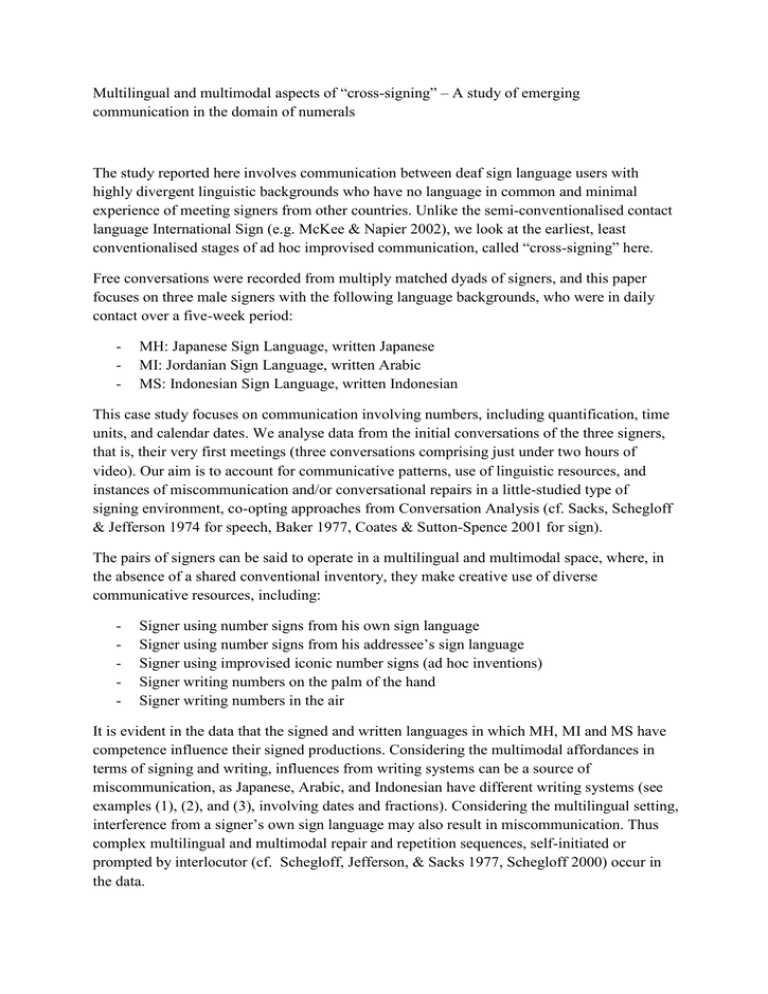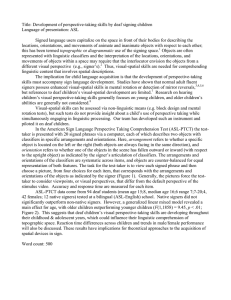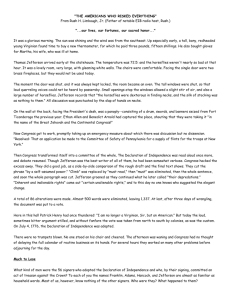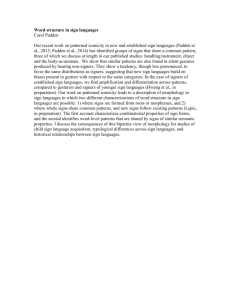Multilingual and multimodal aspects of “cross-signing” – A study of... communication in the domain of numerals
advertisement

Multilingual and multimodal aspects of “cross-signing” – A study of emerging communication in the domain of numerals The study reported here involves communication between deaf sign language users with highly divergent linguistic backgrounds who have no language in common and minimal experience of meeting signers from other countries. Unlike the semi-conventionalised contact language International Sign (e.g. McKee & Napier 2002), we look at the earliest, least conventionalised stages of ad hoc improvised communication, called “cross-signing” here. Free conversations were recorded from multiply matched dyads of signers, and this paper focuses on three male signers with the following language backgrounds, who were in daily contact over a five-week period: - MH: Japanese Sign Language, written Japanese MI: Jordanian Sign Language, written Arabic MS: Indonesian Sign Language, written Indonesian This case study focuses on communication involving numbers, including quantification, time units, and calendar dates. We analyse data from the initial conversations of the three signers, that is, their very first meetings (three conversations comprising just under two hours of video). Our aim is to account for communicative patterns, use of linguistic resources, and instances of miscommunication and/or conversational repairs in a little-studied type of signing environment, co-opting approaches from Conversation Analysis (cf. Sacks, Schegloff & Jefferson 1974 for speech, Baker 1977, Coates & Sutton-Spence 2001 for sign). The pairs of signers can be said to operate in a multilingual and multimodal space, where, in the absence of a shared conventional inventory, they make creative use of diverse communicative resources, including: - Signer using number signs from his own sign language Signer using number signs from his addressee’s sign language Signer using improvised iconic number signs (ad hoc inventions) Signer writing numbers on the palm of the hand Signer writing numbers in the air It is evident in the data that the signed and written languages in which MH, MI and MS have competence influence their signed productions. Considering the multimodal affordances in terms of signing and writing, influences from writing systems can be a source of miscommunication, as Japanese, Arabic, and Indonesian have different writing systems (see examples (1), (2), and (3), involving dates and fractions). Considering the multilingual setting, interference from a signer’s own sign language may also result in miscommunication. Thus complex multilingual and multimodal repair and repetition sequences, self-initiated or prompted by interlocutor (cf. Schegloff, Jefferson, & Sacks 1977, Schegloff 2000) occur in the data. Some of the conversational sequences are best viewed as a collaborative activity between two signers working together to negotiate meaning. This is evident in their turn-taking behaviour including overlapping turns and mirroring each other’s signed productions. The patterns of turn-taking show that signers make a conscious effort to accommodate each other, repeating each other’s signs and/or involving overlap in turns. A Conversation Analysis (CA) approach (e.g. Jefferson 1986, Schegloff 2000) can account for some of these patterns, but it is also clear that signed communication in this unusual setting has properties that are not easily accommodated under conventional theoretical frameworks applied previously to spoken and signed languages. References Baker, Charlotte: Regulators and turn-taking in American Sign Language discourse. 1977. In: Friedman, Lynn A. (ed): On the other hand: New perspectives on American Sign Language. New York : Academic Pr. pp. 215-236. Coates, Jennifer & Sutton-Spence, Rachel. 2001. “Turn-taking patterns in deaf conversation.” In: Journal of Sociolinguistics 5(4): 507-529. Jefferson, Gail. 1986. “Notes on ‘latency’ in overlap onset.” Human Studies 9(2/3):153–183. McKee, R. & Napier, J. (2002). Interpreting into International Sign Pidgin: An Analysis. Sign Language & Linguistics 5, 1: 27-54. Sacks, Harvey, Emanuel A. Schegloff & Gail Jefferson. 1974. “A Simplest Systematics for the Organization of Turn‐Taking for Conversation.” Language 50(4): 696–735. Schegloff, Emanuel A. 2000. “Overlapping Talk and the Organization of Turn-Taking for Conversation.” Language in Society 29(01):1–63. Schegloff, Emanuel A., Gail Jefferson & Harvey Sacks. 1977. “The Preference for Self-Correction in the Organization of Repair in Conversation.” Language 53(2):361–382. Schegloff, E. A. 0. 200“When ‘Others’ Initiate Repair.” Applied Linguistics 21(2): 205–243. Summary of example interactions: (1) MI tries to ask MH when he arrived. MH answers with the Japanese SL sign for ‘June’ (which looks like the number ‘6’), then self-corrects, signing, ‘No, it was earlier; it was May 29’ (which looks like the numbers ‘5’, then ‘2’, then ‘9’). MI does not understand as he uses a different date structure. MH realises this is the problem and signs ’29 / 5’ instead, with a traced ‘dash’ between the day and month. (2) MI asks MH if he has many deaf friends, but MH does not understand MI’s sign for ‘friend’. MI then signs ‘people’. MH, thinking the question is how many deaf people there are in Japan, answers using a fraction ‘one in one thousand’, signing ‘one thousand’ (an iconic ad hoc invention rather than the Japanese sign) followed by a horizontal line following by ‘one’, as this “bottom-to-top” structure is the way to write fractions in Japanese. As Indonesian writing of fractions is “top-to-bottom”, and there is already a miscommunication about the question being asked, MI does not understand even after repetitions and repairs by MH. (3) MS wants to say that a group of deaf people will travel to London on 26 June. He signs the date according to the order used in Arabic, first ‘six’ for the month, then ‘six two’ for 26, as spoken Arabic uses “six-and-twenty” rather than “twenty-six”, and this is mirrored in Jordanian Sign Language. As MI cannot understand these numbers, MS writes on the palm of his hand, and then writes the numbers into the air, first writing and Arabic ‘6’, then self-correcting and writing the complete sequence ‘6-2-6’, this time with a different order.




